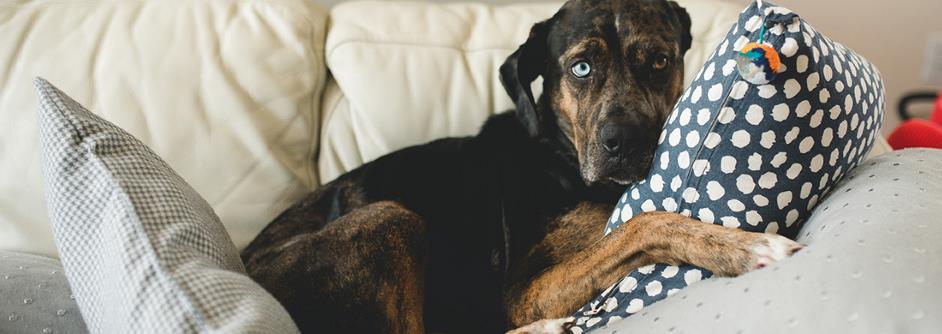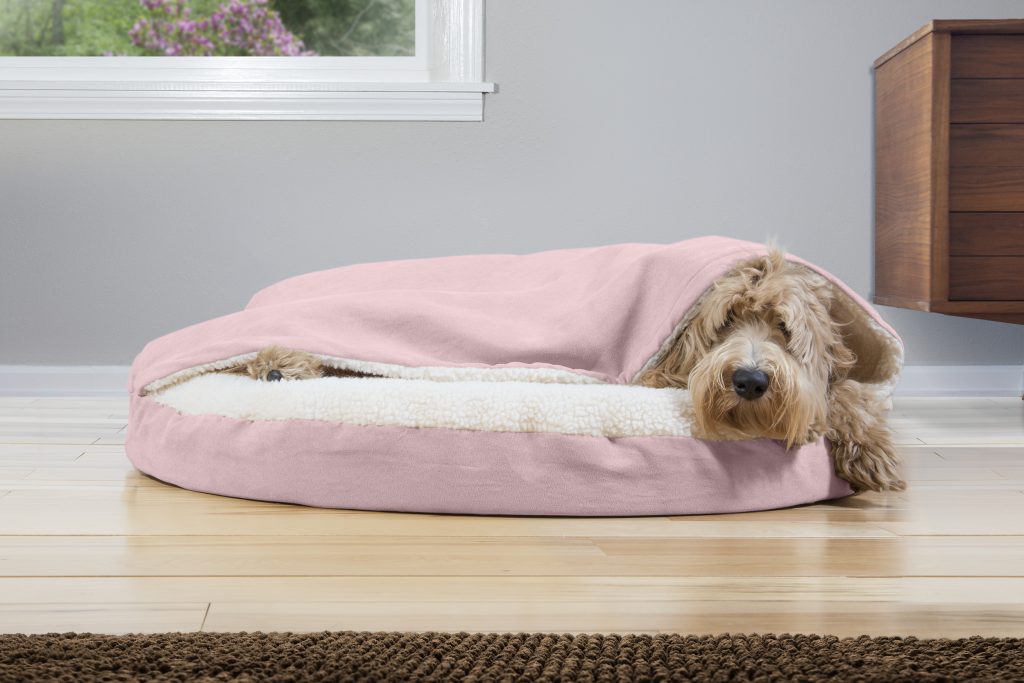Pet parents may not want pups on the couch for various reasons. The most common one relates to health and safety concerns. Some dogs shed nonstop and leave traces of fur everywhere.
They can also leave dirt and marks on the furniture. Some stains can be stubborn or leave foul odors. As a result, some dog owners reupholster their pieces with a pet-friendly fabric while others conclude that the furniture is a pet-free area.
To be fair, some pet owners couldn’t care less about dogs on the couch. But for those who mind, some tips to keep the couch pup free may come in handy.
Why do pets stay on the couch, to begin with? Your furry friends love curling up anywhere comfortable, that includes your bed and sofa. Further, they love it because it’s their favorite zone, and you are their favorite hooman. Your fur baby likes spending time with you.
Today, we will list down some tips that will help you keep Fido off the couch. These tips may prove useful when establishing routines with a young dog or retraining an older one because you allowed them on the furniture before.
5 Ways To Keep Your Dog Off The Couch
1. Stick to the Rule
Consistency is key when teaching your canine friend new behavior. Hence, you would want to be firm that they cannot lie on the couch. It will be easier for Fido to learn the rule if everyone at home expects the same behavior from him.
Spread the word to everyone at home and stick to the rule. Your dog-sitter and house guests should be aware of this as well. This way, you can reinforce the rule and encourage the desired behavior smoothly.
The rule should be applied at all times, under any circumstance. If your pet should stay off the piece, then he should never be on the piece. If mom doesn’t allow staying on the couch today, and then dad suddenly invites him on the next day, your four-legged friends will be confused.
If you have any furniture at home, this may confuse your dog, too. Again, be consistent. Make sure that rule is clear: they cannot sit on any couch in the house. Your dog may sneak in and test out a couch in a different room. To avoid this, keep your pets out of the room.
2. Teach them “off”
It will be easier for you to teach Fido a long-term routine if you had trained them right when they were young. However, your furry friend may not be a pup anymore when you realized that you want to keep the couch pet-free. Don’t worry because you can still train them to a routine, though it may take a longer time.
Pet owners and dog trainers alike use the “off” cue. You can try and teach this to your pet, too. When you say “off,” your four-legged friend should put all their feet on the ground. This cue helps in many situations, not only in luring them away from the couch.
Rewards play a significant part when training your pet. When Fido sits on the couch, ask them to get off and toss a treat to the ground. Treats serve as persuasion. If your pet does not cooperate, you will need to take them to the ground. If they carry out your request, give them rewards. Aside from treats, you can give them toys, cuddles, or playtime. Pats and praises also work well with most dogs.
Training takes time and repetition. Practice makes perfect, so practice, practice, practice! In time, your furry friend will start to avoid sitting on the couch completely.
Remember that you want to use positive reinforcers when teaching your pets. Be patient with them and avoid yelling or hitting. You would want to train them in a safe and friendly manner.
In worse cases, a pet can be territorial towards the furniture. Your pet can gnash or bark when someone tries to occupy the sofa. If you did everything you could and your pet won’t move, maybe it’s time to call a skilled dog trainer for help.
3. Make them Love their own Bed
Your dog probably loves hanging on the couch because their bed is not comfortable enough. Their comfort is your mission, so try and see what could be lacking on their bed. Give your pet a soft and warm bed that is spacious enough for them to rest cozily.
Leather is the go-to fabric choice of pet parents when it comes to pet-friendly furniture. They also trust microfiber, suede, and other tightly-woven fabrics. Yorkshire Fabric Shop is an online retailer of durable and stylish fabrics. They have leather, velvet, suede, and other fabrics in various colors, patterns, and sheens.
Another reason your furry friend adores the couch is that you are there. If you will not let them sit on it, give them a pleasant alternative. You can place their furniture near yours so that they can feel that you’re still close by.
Train them to go to their own space by telling them, “go to bed” while pointing at it. Toss a treat on their bed or pat them on the head when they follow.
4. Utilize a Physical Barrier
Have you heard of the idiom, when the cat is away, the mice will play? Let us use it for a little analogy. Without a watchful eye, your dog might break the rules. Hence, you should try some methods to manage them, especially when you are leaving the house.
You can make use of physical barriers to prevent your pet from climbing the couch. These include an upturned laundry basket or a chair. Or, you can rely on classic barriers like the crate and pet gate.
Also, you can buy products designed to keep pets off the couch. These include furniture pads, the Couch Defender, and X-Mat Pet Training Mat.
Couch Defenders is a barrier that is cylindrical in shape. You can put it on the furniture when not in use. They keep the couch occupied so that there is no space for your dog to sit on. Some products designed for the same purpose might scare them away. However, Couch Defenders is a totally humane barrier. Plus, they come in neutral colors so they can easily match any interior.
Whatever product you choose to use in keeping your couch pup free, please be sure to avoid those that will scare your furry friend. Some products in the market can inflict pain or fear. These could frighten your dog, leaving long-term fear towards the furniture and you. Further, it does not teach them the behavior that you want them to learn.
Some Products I don’t Recommend are:
1. Mats with static electricity. This product’s feature may not cause pain. However, this can give your pet great discomfort. This mat seems like a punishment for unwanted action rather than a method to help your pet learn the desired behavior.
2. A can of pennies that you would shake to startle your pet. This can cause a negative impact and terrify your dog.
3. A mat that gives out a 95-decibel beep when Fido steps on it. A sound within 95 decibels is considered very loud, comparable to that of a running motorcycle engine. Any sound 90 decibels and beyond is dangerous for both humans and pets. It could cause hearing problems. Also, loud noise can be upsetting and may lead your dog to avoid the sofa and its nearby spots for the wrong reasons.
5. Try a Positive Interrupter
Positive interrupters are cues that sidetrack your dog and reorient them to you. These cues do not intend to annoy or scare your fur baby. Dog parents are free to choose their own noise or cue. Some of the common cues are related to food such as “treat,” “cupcake,” and “sprinkles.”
When your dog steps on the furniture, say the cue. Once you get their attention, tell them “off.” If they obey, reward them.
If you want to try this technique, avoid using words that evoke yelling or negative feelings. This includes “stop,” “bad dog,” and “no.”
Final Thoughts
It is a pleasure to share these tips with you. I wish you the best of luck in training your dog and keeping the couch clean.
Again, please be mindful of the methods you use when training your pets. Some techniques may take a longer time than you imagined, so please be patient and trust the process.
Aversive techniques may work, but I do not recommend them. Training your pet should be a learning experience for you and them. It should strengthen your bond and help you understand your living dynamics. It should not be about shocking and scaring them until they behave according to how you want.
By using negative reinforcements, you are exposing your pet to a stressful situation. This can result in feelings of fear and behavioral problems which are far worse than a couch problem.
See you next time! Make good choices, and stay creative!
Share your thoughts with us in the comments below!
 DogExpress
DogExpress






















 in Chandigarh, India.
in Chandigarh, India. 

